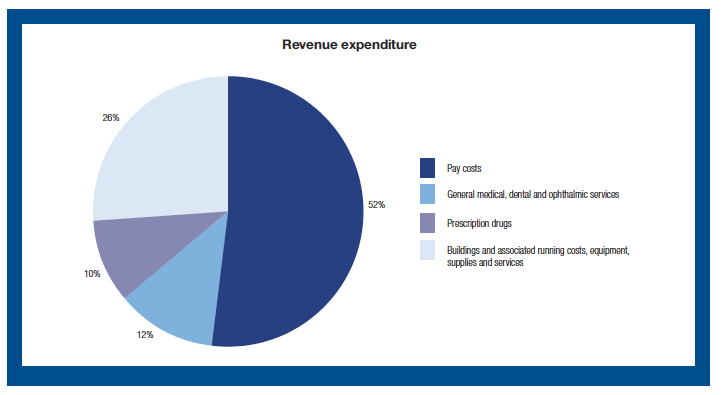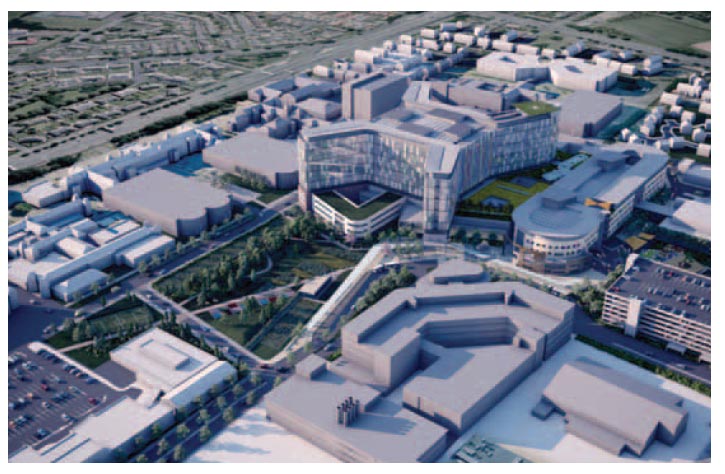NHSScotland Chief Executive's Annual Report 2012/13
The NHSScotland Chief Executive's Annual Report 2012/13 presents an assessment of the performance of NHSScotland in 2012/13 and describes key achievements and outcomes.
Chapter 6 Financial Performance
FINANCIAL PERFORMANCE
This chapter provides a summary of the key information relating to the financial performance of NHSScotland during 2012/13. The performance for the year was excellent with the key financial performance target, the Departmental Expenditure Limit (DEL), showing a small underspend.
NHSSCOTLAND FINANCIAL PERFORMANCE SUMMARY 2012/13
| Departmental Expenditure Limit ( DEL) |
Revenue £m |
Capital £m |
|---|---|---|
| Actual |
10,712 |
542 |
| Under/(Over) Spend |
4 |
0 |
The level of spend available to NHSScotland is significant and it is important that it is managed effectively to deliver the best results for patients and good value for public funds. This is achieved by planning and managing financial performance across the whole of the budget, not only its constituent parts. The totality of the resource available to the Scottish Government Health and Social Care Directorates is therefore used fully and effectively.
The bulk of the above expenditure lay with the 22 NHS Boards, all of which achieved their financial targets in line with projections, all with unqualified accounts for the fifth year in a row. The £4 million underspend represents less than 0.1 per cent of the Health budget and has been achieved through the more efficient delivery of a range of policy programmes across the Scottish Government Health and Social Care Directorates.
The strong financial position was maintained while directing additional resource in key clinical priorities such as:
- Contribution to rare medicines drugs fund - In January 2013 we launched a fund to cover the cost of medicines for individual patients with rare conditions, which are not available for routine prescription. £21.7 million will be invested to pay for the cost of medicines known as 'orphan drugs'. These are medicines for illnesses which affect fewer than one in 2,000 people.
- eHealth and additional funding for mobile devices (e.g. digipens) - We provided a £1 million fund to boost access to mobile technology for nurses working in the community. The aim is to accelerate the achievement of benefit enabled by increased use of innovative data access and capture initiatives in the community. The additional funding will mean nurses will be able to access patient information or to update records electronically. The new fund will cut down nurses' administration time allowing them to spend more time with patients.
- Insulin pumps - On 21 October 2011, the then Cabinet Secretary for Health, Wellbeing & Cities Strategy announced the decision to commit NHSScotland to substantially increasing the availability of insulin pump therapy across Scotland to ensure equity of access. In order to support NHS Boards in meeting this key Ministerial commitment, the Scottish Government provided funding of £3.1 million for the purchase of pumps and consumables in 2012/13.
- Digital mammography - In October 2012, as part of the Detect Cancer Early initiative, the Cabinet Secretary for Health and Wellbeing announced funding
to transform the programme from its current analogue equipment to digital mammography. Revenue funding of £2 million and capital funding of £1 million
was provided to assist in the rollout which is now taking place in Scotland and
is planned to conclude in 2015.
This report does not present the full accounts of NHSScotland, which form part of the overall Scottish Government consolidated accounts. The audit of the Scottish Government consolidated accounts for 2012/13 is unqualified. Audit Scotland has reviewed the accounts of all NHS Boards for 2012/13 and given an unqualified audit opinion on each. It will provide an independent commentary on NHSScotland finances in its health sector overview report.
REVENUE EXPENDITURE
NHSScotland's revenue expenditure of £10,712 million in 2012/13 represented over £2,000 for every person living in Scotland. Around 52 per cent of this funds staff costs for NHSScotland employees. A further 10 per cent goes on prescription drugs; 12 per cent on general medical, dental and ophthalmic services; with the remaining 26 per cent funding buildings and associated running costs, equipment, supplies and services.
Chart 13

KEY EXAMPLES OF CAPITAL EXPENDITURE PROGRAMMES
Capital expenditure was £542 million in 2012/13 and showed a breakeven position. The money was used to fund numerous NHSScotland projects across the country such as the New South Glasgow Hospitals Project. When completed in early 2015, the £842 million publicly funded 'super campus' will deliver a truly gold standard of healthcare on the Govan site with maternity, children's and adult acute hospital and laboratory services all together on one site for the first time in Glasgow. The new adult hospital sits alongside the new children's hospital and both will be linked via a subterranean tunnel to the new £90 million laboratory which is already operational having opened last year. The project - which is the largest single NHS hospital building project ever undertaken in Scotland - is on track to be delivered on time and on budget at the beginning of 2015.
Through the use of revenue finance we are developing five major capital projects within health and a pipeline of Primary Care and community projects via the hub initiative. Projects with a total value in the region of £750 million via the Royal Hospital for Sick Children and Department of Clinical Neurosciences in Edinburgh, North Ayrshire Mental Health and Community Hospital, Dumfries and Galloway Royal Infirmary, Scottish National Blood Transfusion Service development and re-provision of services at Balfour Hospital in Kirkwall.
HEAT TARGET
NHS Boards are required to operate within their Revenue Resource Limit (RRL), their Capital Resource Limit (CRL) and meet their Cash Requirement.
All Boards met their 2012/13 financial targets.

The new South Glasgow Hospitals Campus, NHS Greater Glasgow and Clyde, will deliver a truly gold standard of healthcare on the Govan site, with maternity, children's and adult acute hospitals, and state of the art laboratory services all together on the one campus.
It will also have the biggest critical care complex and one of the biggest emergency departments in Scotland.
Contact
Email: Andrew Wilkie
There is a problem
Thanks for your feedback